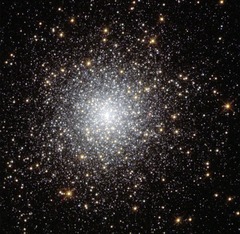NGC 1049 is a globular cluster located in the Local Group galaxy of the Fornax Dwarf, visible in the constellation of Fornax. At a distance of 460,000 light years, it is visible in moderate sized telescopes, while the parent galaxy is nearly invisible. This globular cluster was discovered by John Herschel on October 19, 1835,[3] while the parent galaxy was discovered in 1938 by Harlow Shapley.[4]
| NGC 1049 | |
|---|---|
 NGC 1049 by Hubble Space Telescope | |
| Observation data (J2000 epoch) | |
| Class | V |
| Constellation | Fornax |
| Right ascension | 02h 39m 52.5s[1] |
| Declination | −34° 16′ 08″[1] |
| Distance | 143±3 kpc[2] |
| Apparent magnitude (V) | +12.9 |
| Apparent dimensions (V) | 24″ |
| Physical characteristics | |
| Other designations | Hodge 3 |
References
edit- ^ a b "SIMBAD Astronomical Database". Results for NGC 1049. Retrieved 2006-11-17.
- ^ Oakes, Elias K.; Hoyt, Taylor J.; Freedman, Wendy L.; Madore, Barry F.; Tran, Quang H.; Cerny, William; Beaton, Rachael L.; Seibert, Mark (2022). "Distances to Local Group Galaxies via Population II, Stellar Distance Indicators. II. The Fornax Dwarf Spheroidal". The Astrophysical Journal. 929 (2): 116. arXiv:2204.09699. Bibcode:2022ApJ...929..116O. doi:10.3847/1538-4357/ac5b07. S2CID 248260222.
- ^ Seligman, Courtney. "NGC 1049 (= GCL 3 in the Fornax dwarf galaxy)". Celestial Atlas. Retrieved 7 December 2018.
- ^ Shapley H (1938). "Two Stellar Systems of a New Kind". Nature. 142 (3598): 715–6. Bibcode:1938Natur.142..715S. doi:10.1038/142715b0. S2CID 4071472.
External links
edit- Media related to NGC 1049 at Wikimedia Commons
- NGC 1049 on WikiSky: DSS2, SDSS, GALEX, IRAS, Hydrogen α, X-Ray, Astrophoto, Sky Map, Articles and images